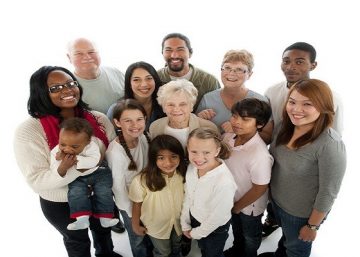I am sure we have all heard much too often clichés such as “_______ knows no boundaries” or “things can be worse.” I have never cared for such clichés because they invalidate subjective experiences, whether they are negative, neutral, or positive. As a social worker, I have had the opportunity to work with children and their families in various settings: schools; mental health clinics; and the foster care system. For the past 25 years, I have worked as a hospice social worker.
No amount of education or work experience can prepare a parent for having a child diagnosed with a chronic disease like spondylitis. It is normal to feel lost and disconnected with the world when your child receives the diagnosis. Your home, family, personal, and child’s equilibrium are disrupted. You are overwhelmed with mixed emotions and feelings such as anger, denial, and sadness. It’s called grief, and it is a natural, human, and necessary process when experiencing some form of loss. We all hope and pray that our children will grow to be healthy, happy, and successful adults. What makes an individual happy and successful is unique and personal but good health is a universal concept. A diagnosis of a chronic disease signifies a loss; a loss of good health and potential future losses related to the disease. Thus, loss is multi-dimensional.
My son, Miguel, was diagnosed with ankylosing spondylitis (AS) a type of spondylitis in the spring of 2017. The journey has been short although at times, it seems to be an eternity. After my son’s diagnosis, I was consumed with sadness and denial. I recall cancelling my son’s appointments with his rheumatologist and planning not to return; thinking he was misdiagnosed. It took me several months to acknowledge and embrace my grief. Once I embraced my grief and surrendered to my new reality, I was able to focus on my child’s treatment plan. I was also able to recognize the blessings. My son was fortunate enough to have been referred to Rady Children’s Hospital Rheumatology Program and received an early diagnosis. This reduced the risk of any structural damage in the sacroiliac joints. Although pain was an issue in the beginning, early diagnosis and treatment have been positive.
As parents with children suffering from a chronic disease such as spondylitis, we need to continuously monitor our child’s mental health. Every day we are bombarded by social media about how research studies show that depression and anxiety in children and teens are on the rise. Reasoning for the increase will vary depending on the focus of the research. Depression and anxiety may shadow our child. Why? Because chronic pain and any other symptoms related to any form of spondylitis can be both mentally and physically debilitating. It is well known that chronic pain can lead to depression. “Depression and chronic pain share some of the same nerve pathways in the brain and spinal cord” (“Depression and Chronic Pain”, WebMD 2018). It can also become a vicious cycle: if there is pain, anxiety may set in and potentially lead to depression thus, increasing pain. “The overlap of anxiety, depression, and pain is particularly evident in chronic and sometimes disabling pain syndromes…” “(The pain-anxiety-depression connection” Harvard Health Publishing, 2010-2019).
It is important that as parents and caregivers be able to differentiate between sadness and depression. “Being depressed” is a term that often times is inappropriately and overly used in the social platform, which can confuse a child’s understanding of depression. It is normal for a child to sometimes feel sad. It is part of the human experience. The concern arises when the sadness is persistent and is accompanied by other symptoms such as loss of appetite, irritability, anxiety, social isolation, insomnia and/or increase sleeping, regular activities that were once enjoyed are no longer enjoyed (anhedonia), inability to concentrate, and academic performance begins to decline. Younger children may cling onto a parent and/or regress developmentally. Some children may even act out verbally and/or become physically aggressive.
I have opted to focus more on the positive outcomes when addressing my son’s issues, although this can be taxing and at times challenging. When my son was first diagnosed, I was overwhelmed reading about AS from different social platforms and it only increased my anxiety and fear and depression did set in. The information available can be quite alarming due to the fact that not all social platforms are reliable. I discussed with my son’s rheumatologist my concern and besides providing ongoing education regarding my son’s AS diagnosis, he also recommended that I look into the Spondylitis Association of America (SAA) for further information regarding the disease. This has been a very positive experience. As parents and caregivers of a child suffering from spondylitis, we have the unique and incredible opportunity to guide and teach our children how to better cope with the adversities that may arise from suffering with a chronic disease. We may not have control over the disease, but we have control over the tone we will set in dealing with the disease and how we will embrace the challenge. Independent from our child’s diagnosis, life is always filled with many storms that we need to learn to navigate through. With more reason, we need to try to provide an environment where our little warriors feel reassured, confident, and capable. This will make them stronger and resilient.
I am speaking not only as a mother with a child who suffers from ankylosing spondylitis but also as a professional. Embrace your new reality as well as your grief. It is healthy and necessary. Give yourself permission for personal time and/or engage in activities that will help you recharge physically, emotionally, psychologically, and spiritually. Surround yourself with positive affirmations. Read books that inspire you and encourage you to grow. Continue reading and learning about your child’s disease. Also, read about overall child development in order to better understand normal growth. Children go through stages of development in several areas: physical, emotional, psychological, language, social, etc… As they go through the stages, they need to acquire certain tasks. Having a basic understanding of child development will help you become better aware of your child’s needs and how the disease may be affecting them. For example, younger children have limited vocabulary which limits their ability to fully describe symptoms. Especially pain. Sometimes children may regress developmentally when experiencing pain or depression. Also, engage with your child in healthy fun activities that may help divert their focus from the physical pain even if for a few minutes. My son enjoys playing chess and listening to classical music. He also enjoys taking walks while admiring the sunset that greets him. New areas of research that present positive results in the management of pain, depression, and anxiety include music and art therapy, guided imagery therapy, and yoga for children and teens. Most importantly, try to normalize your child’s home setting. You don’t want them to feel any more different then what they already feel. Dismiss those clichés and stay focused. Yes, treat the disease for what it is but acknowledge your child for who they are: they are still the same child they were before being diagnosed with a chronic disease. They want to play, dance, go on adventures, go to the movies, and do whatever it is that brings joy to their little hearts, even it means seeing their favorite movie for the 10th time in one day. Also, take time to listen to their silence . . . silence can say more than words and that is just fine.
Lastly, always consult with your child’s rheumatologist and/or any other medical specialists involved with your child’s care. Request for professional referrals for other treatment modalities in helping address specific issues. For example, when dealing with pain, besides following the medical treatment plan, a referral to a psychologist or social worker may be recommended in order to learn alternative healthy coping mechanisms. Physical therapy may also be recommended.
The SAA is the best site to start learning about spondylitis. If possible, attend a support group in your area sponsored by the SAA. If you live in the San Diego or South Riverside County areas in Southern California, you can attend either the So Cal Parent Support Group or the SoCal SpA Caregivers Support Group. These groups are designed to provide a safe environment where parents and caregivers can share their stories, vent, share resources, and also learn more about the disease as well as comfort measures and coping mechanisms.
Pain is no evil unless it conquers us. -George Eliot
Submitted by: Belen Diaz de Leon-Gonzalez, MSW




You must be logged in to post a comment.